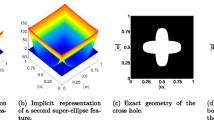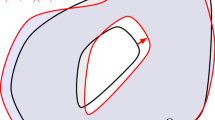Abstract
This paper presents a numerical solution for shape optimization problems for link mechanisms, such as a piston-crank mechanism. The dynamic behavior of a link mechanism is described by a differential-algebraic equation (DAE) system consisting of motion equations for each single body and constraints of linkages and rigid motions. In a shape optimization problem, the objective function to maximize is constructed from the external work done by a given external force, which agrees with the kinetic energy of the link mechanism, for an assigned time interval, and the total volume of all the links forms the constraint function. The Fréchet derivatives of these cost functions with respect to the domain variation, which we call the shape derivatives of these cost functions, are evaluated theoretically. A scheme to solve the shape optimization problem is presented using the H 1 gradient method (the traction method) proposed by the authors as a reshaping algorithm, since it retains the smoothness of the boundary. A numerical example shows that reasonable shapes for each link such that mobility of the link mechanism is improved are obtained by this approach.






Similar content being viewed by others
References
Adams RA, Fournier JJF (2003) Sobolev spaces, 2nd edn. Academic, New York
Amirouche F (2006) Fundamentals of multibody dynamics: theory and applications. Birkhäuser, Boston
Armijo L (1966) Minimization of functions having Lipschitz-continuous first partial derivatives. Pac J Math 16:1–3
Azegami H, Takeuchi K (2006) A smoothing method for shape optimization: traction method using the Robin condition. Int J Comput Methods 3(1):21–33
Azegami H, Kaizu S, Takeuchi K (2011) Regular solution to topology optimization problems of continua. JSIAM Lett 3:1–4
Azegami H, Fukumoto S, Aoyama T (2012) Shape optimization of continua using NURBS as basis functions. Struct Multidisc Optim 47(2):247–258
Bremer H (2008) Elastic multibody dynamics: a direct Ritz approach. Springer, New York
Featherstone R (2008) Rigid body dynamics algorithms. Springer, New York
Nocedal J, Wright SJ (2006) Numerical optimization. Springer, New York
Sokolowski J, Zolésio JP (1992) Introduction to shape optimization: shape sensitivity analysis. Springer, New York
Wolfe P (1969) Convergence conditions for ascent methods. SIAM Rev 11:226–235
Acknowledgement
The present study was supported by JSPS KAKENHI (20540113).
Author information
Authors and Affiliations
Corresponding author
Additional information
This paper was presented at CJK-OSM 7, 18–21 June 2012, Huangshan, China.
Rights and permissions
About this article
Cite this article
Azegami, H., Zhou, L., Umemura, K. et al. Shape optimization for a link mechanism. Struct Multidisc Optim 48, 115–125 (2013). https://doi.org/10.1007/s00158-013-0886-9
Received:
Revised:
Accepted:
Published:
Issue Date:
DOI: https://doi.org/10.1007/s00158-013-0886-9




